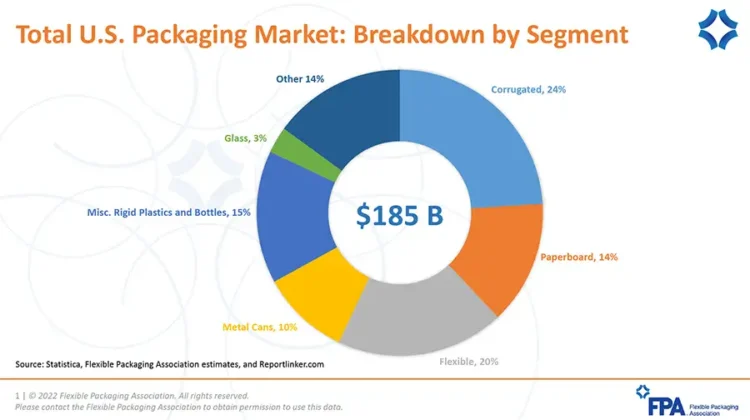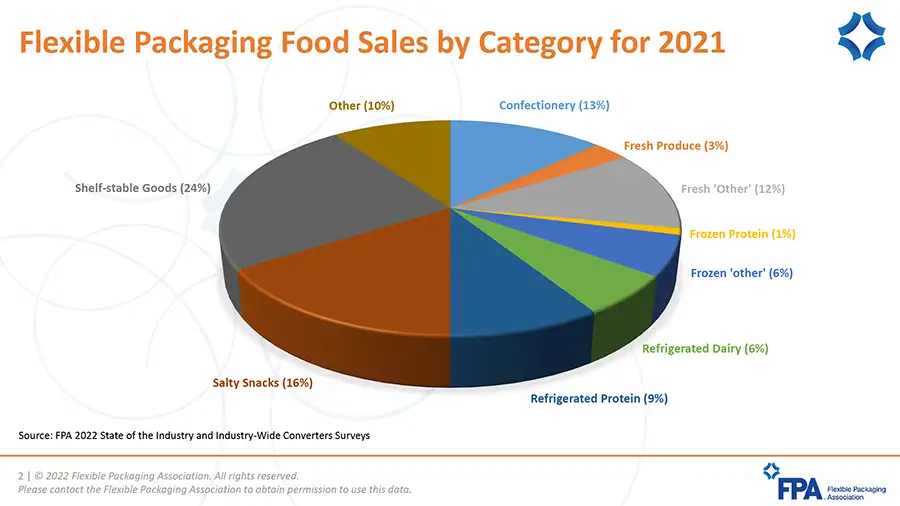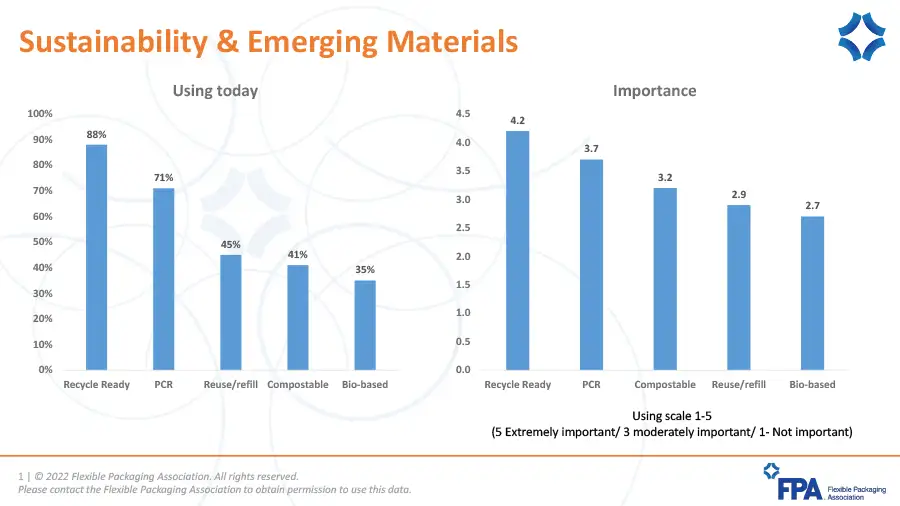
Flex packs now account for 20% of the $185-billion US overall market, with food making up more than
half of all end-use packaging applications.
By Alison Keane, Esq., CAE, IOM, president and CEO, Flexible Packaging Assn. (FPA)
For the first time since 2014, the percentage growth for the US flexible-packaging industry has grown from a steady 19% to 20% of the overall US packaging market by segment. This number may be higher given the unprecedented growth over the last two years; however, the latest census data is not available yet, so this is a conservative estimate. At $39 billion in 2021, up from $34.8 billion in 2020, the industry had the highest growth – 12.1% – in at least 20 years (see Figure 1).

Food continues to be the biggest end-use segment for the US flexible-packaging industry, with 52% of the market; next to medical and pharma at 14%; industrial at 8%; other retail-non food at 7%; beverages at 6%; non-retail food at 5%; pet-food and personal-care at 4% each; consumer products at 2%; and institutional non-food and tobacco coming in at 1% and <1%, respectively. Because food represents such a large portion of end-use applications, FPA broke down the food segment into categories for our 2022 State of the US Flexible Packaging Industry Report (SOI). As seen in Figure 2, shelf-stable goods is the largest category, with 24%, followed by salty snacks and confectionery at 16% and 13%, respectively. Refrigerated protein (9%) and refrigerated dairy (6%) together account for another significant portion of food flexible-packaging applications.

Trends in key issues continue for converters and suppliers alike
The top three issues for both US flexible-packaging converters and suppliers to the industry were the same in 2021 – labor and talent (recruitment and retention); raw-material supply and costs; and sustainability. While sustainability was No. 3, it remains a key issue and one that is particular to the packaging industry, as labor and the supply chain are both disrupting all manufacturing. This is because of the enormous amount of pressure to do something about packaging waste. For this reason, FPA asked a few new questions about sustainability and emerging materials/systems in our 2022 SOI.
When asked what emerging materials and systems were being used today, recycle-ready packaging came in first, with 88% of respondents saying they were manufacturing such flexibles today. Seventy-one percent of respondents stated that they were making flexibles with post-consumer recycled (PCR) content today, and 35% said they were using bio-based materials. Refillable and reusable systems were being produced by 45% of respondents, and 41% were converting compostable structures. When asked what importance these structures and systems would have over the next five years, almost all were rated as “moderately” to “extremely important,” and none were rated as “not important.” Recycle-ready and PCR-content again came in as Nos. 1 and 2 (see Figure 3).

Again, given the significant legislation and regulation surrounding packaging waste, these results are not surprising as converters and suppliers are positioning themselves to help brand owners fulfill their circularity goals. The goals, while voluntary and lofty in nature, answer to a host of drivers (environmental, social and governance (ESG) investors, consumers, the Ellen MacArthur Foundation and major retailers, among others), and now have been mandated through numerous pieces of legislation throughout the US. We now have four different extended producer responsibility (EPR) laws on the books – Maine, Oregon, Colorado and California, as well as multiple PCR-content laws; laws regulating the use of PFAS as well as other chemicals in packaging; and the potential for conflicting labeling for recyclability laws among states.
Investment in new packaging-recycling infrastructure…but how?
Thus, advocacy remains at the forefront of FPA’s work. While we need to continue to educate and promote the many sustainability benefits of flexible packaging, we also need to help solve the last piece of the circularity puzzle and that is collecting, reprocessing and reusing flexible-packaging material again. This can be done only through investment in modernizing our US recycling systems, both mechanical and chemical. This investment may come from EPR bills, which will mandate a certain fee on all packaging sold in the state, which should go to stabilizing the current infrastructure as well as the addition of new infrastructure to recycle all packaging waste. Unfortunately, it remains to be seen whether these schemes will work.
Maine’s law, for example, appears to be just a tax disguised as EPR, with the state contracting out the functions of the producer responsibility organization and dictating the terms of the fee and payments to municipal governments for the status quo. There is little to no mention of investment in advanced infrastructure and little to no ability for brand owners, who will be paying fees to the state, to dictate where the money will be spent. The opposite would be California’s law, which is so complex that neither the sponsor’s office nor the state implementing body, CalRecycle, knows exactly how it is going to work. While there may be changes to it during the 2023 legislative session to make it more understandable and fix competing and conflicting provisions, the bill really was the lesser of many evils in 2022. It was a compromise bill to escape a ballot initiative that would have placed a tax on all plastic packaging, raising hundreds of millions of dollars annually that would have gone to the state and local governments with very little specificity on how it would be spent, and another bill that would have banned all plastic e-commerce packaging in the state.
Somewhere in the middle are Oregon and Colorado’s EPR bills. With Oregon’s law mirroring some of the complexity of California’s, it at least has more guardrails for the regulations that eventually will implement the program, including cost constraints. Colorado’s appears to be the best example of real EPR, with producers owning and operating the systems that the fees on their products will pay for; allowing for the use of existing infrastructure, but also envisioning new infrastructure; and providing oversight and enforcement through not only the state agency but an advisory committee as well. Colorado’s law is not without its quirks, however, and only time will tell whether any of these states, or new states that will be sure to follow, will provide for systems that don’t just cost consumers more money but actually increase the amount of packaging waste collected and recycled. FPA has detailed factsheets on each of the current state EPR laws at https://www.flexpack.org/advocacy.
What must go in and what can’t
EPR for packaging isn’t the only legislation facing the industry, with PCR-content bills passing in Washington State and New Jersey. With respect to flexibles, both laws are confined to plastic bags now; however, we have seen attempts to broaden the scope in other unsuccessful legislation. Toxicity also is playing a role in packaging legislation, with some bills attempting to conflate chemical use with recyclability and others banning some substances altogether, despite unintended consequences. This is true for PFAS legislation across the country targeting paper and plastic packaging, particularly food packaging.
While most flexible-packaging converters have stopped using certain PFAS in paper food packaging for grease resistance, new bills are targeting a different class of PFAS used as processing aids (see factsheet at https://www.flexpack.org/advocacy). Not only is this unwarranted from a health risk perspective, but it also limits the use of PCR content in films, which conflicts with the PCR mandates already in place. Of course, getting the PCR content also will be an issue if the EPR systems are not designed or implemented in a way that will increase the collection and reprocessing of these materials.
Full circle of circularity
Thus, we have come full circle in the current story of packaging circularity. We’re returned to why converters and industry suppliers are focusing their efforts on more readily recyclable packaging and incorporating PCR content, without compromising the efficacy of the package. Alternative materials and systems are being provided as options for brand owners facing myriad legislation and regulations impacting their packaging choices. To add to the complexity, we know that not all packaging can be substituted without compromising its efficacy, and that many of those packaging types are used for food, pharmaceutical and medical applications – again, flexible packaging’s biggest segments. Even the Ellen MacArthur Foundation in its 2022 “Progress Report,” clearly states only about 5% to 10% of flexible packaging can be eliminated, with the elimination of the remaining formats leading to unintended consequences.
While progress is being made on formats that use mono-materials and metallized film that can be recycled alongside their counterparts, there still are many flex-pack formats that are multi-material for good reason. Aluminum foil, for example, used in various food, nutraceutical, pharma and medical applications, provides a superior barrier for shelf-stability and sterility. There are global supply-chain issues with aluminum foil: Little to no production in the US of converter foil; new tariffs being contemplated on imports of foil; and multi-material packages made with foil can be much harder to recycle. Despite this, there still is a large segment of the industry, and our customers, invested in the arena as there are far too many unintended consequences with substitutions. Thus, FPA continues to state that an aggressive plan and approach to modernizing the US-recycling infrastructure to accept today’s packaging is the only way we will see true packaging circularity without sacrificing health and safety and adding to the waste problem.
Stay informed
So, join in the conversation and unite for flexibles – let’s keep educating and promoting the vast sustainability aspects of flexibles, from fewer greenhouse-gas emissions to “less waste in the first place”®; let’s keep innovating to support our customers’ sustainability goals; and let’s keep pushing our policymakers for smart legislation to invest in modernizing recycling systems to support the packaging we use today and not leave the next generation with the same problems we have today – the unintended consequences of uninformed decisions.
More info: 410-694-0800; email: fpa@flexpack.org, www.flexpack.org

